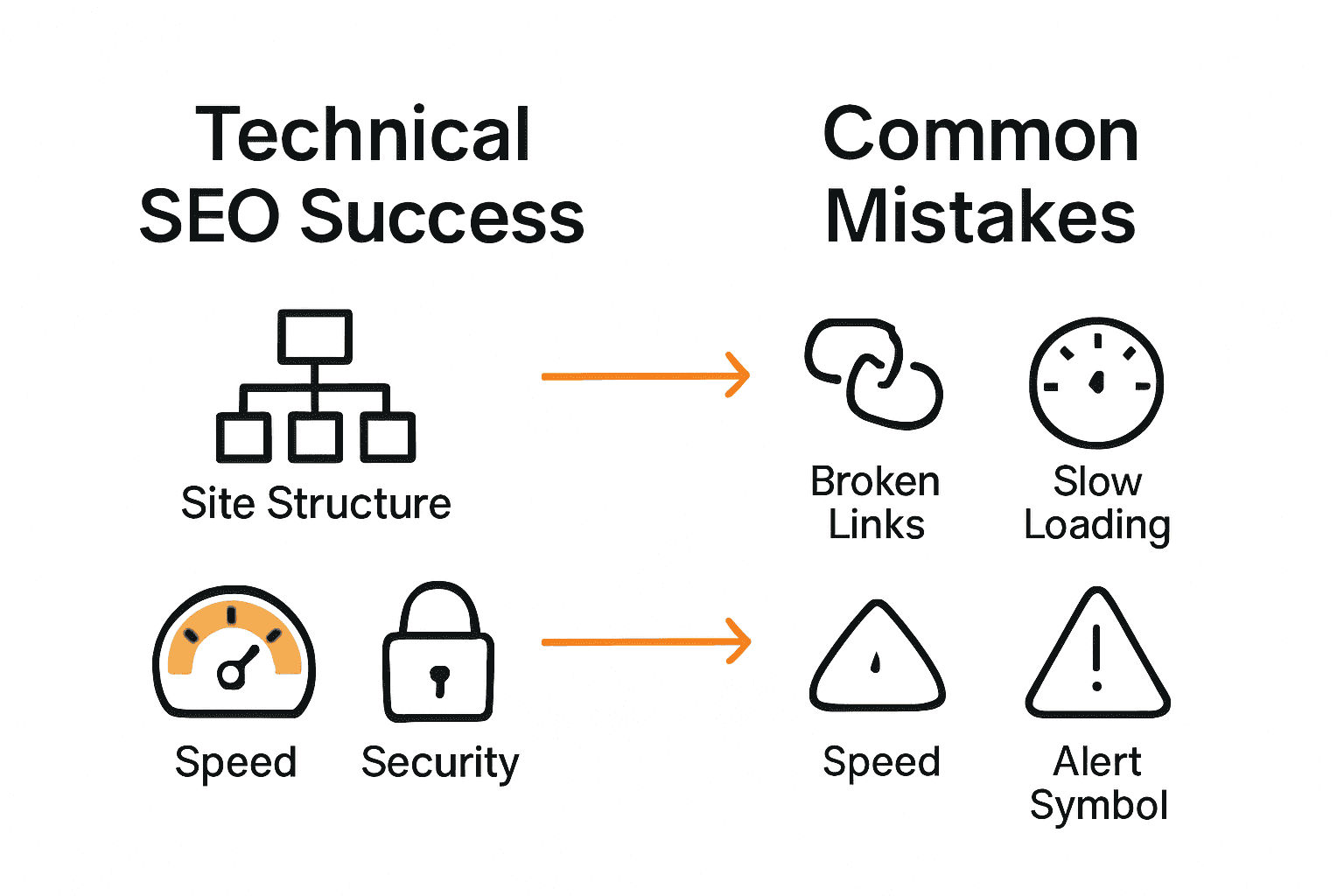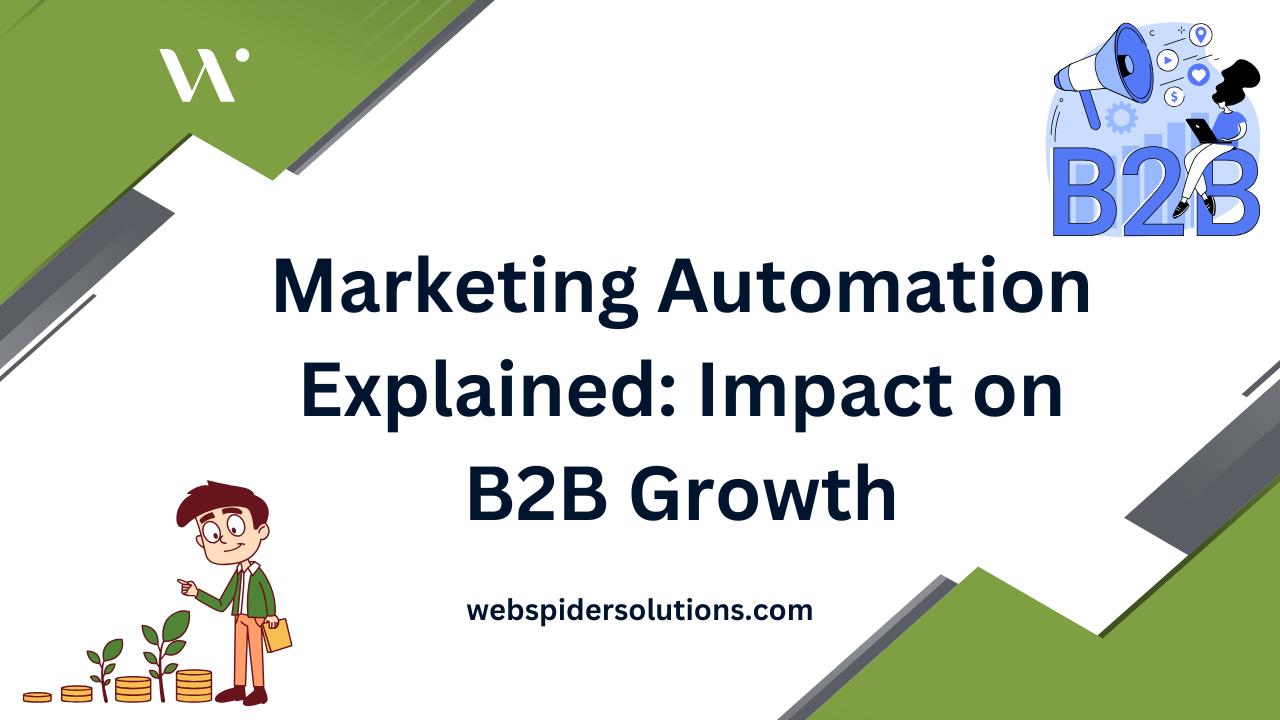Did you know that websites with a clear structure are up to 50 percent more likely to rank on the first page of search results? When your site is easy to navigate, both visitors and search engines find what they need quickly. By mastering the key technical steps, you can strengthen your website’s performance, protect it from common SEO pitfalls, and create a smooth experience that keeps users coming back.
Quick Summary
| Key Point | Explanation |
|---|---|
| 1. Optimize Website Architecture | Ensure your site structure is logical, allowing both users and search engine crawlers to navigate quickly. |
| 2. Improve Site Speed and Mobile Usability | Aim for fast loading times and mobile-friendly design to enhance user experience and retention. |
| 3. Implement Structured Data | Utilize Schema.org markup to help search engines better understand your content and improve visibility. |
| 4. Secure Your Website | Use HTTPS with valid SSL certificates to build user trust and comply with modern ranking factors. |
| 5. Regularly Monitor SEO Performance | Establish a system for tracking key metrics and auditing the site to ensure ongoing optimization efforts are effective. |
Table of Contents
- Step 1: Assess Website Architecture And Crawlability
- Step 2: Optimize Site Speed And Mobile Usability
- Step 3: Implement Structured Data And Indexing Controls
- Step 4: Fix Technical Issues And Enhance Security
- Step 5: Verify Technical Seo Improvements And Monitor Performance
Step 1: Assess Website Architecture and Crawlability
In this critical step, you will evaluate how search engines navigate and understand your website’s structure. Your goal is to create a clear, logical pathway that helps both users and search engine crawlers find information quickly and efficiently.
Start by mapping out your website’s current architecture. Imagine your site as a city map where every page is a building and links are the roads connecting them. According to research from Web Spider Solutions, an optimal website structure ensures no page is more than three clicks away from the homepage.
Begin with a visual site audit. Use tools like Screaming Frog or Google Search Console to generate a comprehensive site crawl. Look for potential roadblocks: pages with zero incoming internal links, deeply nested content, or complex navigation that might confuse search engine bots.
Focus on creating a flat site structure with clear, semantic URLs. This means organizing content into logical topic clusters where related pages link to each other naturally.
For instance, if you have a technology blog, cluster articles about “Cloud Computing” should interlink smoothly, creating a comprehensive resource that search engines can easily understand.
Prioritize scalable architecture. Consider implementing a headless CMS that allows flexible content management and auto-updating sitemaps. This approach ensures your website remains adaptable as your content grows.
The next step involves detailed technical optimization to enhance your site’s crawlability and indexing potential.
Step 2: Optimize Site Speed and Mobile Usability
In this crucial phase, you will transform your website into a lightning-fast mobile-friendly powerhouse that impresses both users and search engines. Your mission is to dramatically improve loading performance and create a smooth user experience across all devices.
Start by understanding Core Web Vitals, the critical metrics that determine your site’s performance. According to recent research, you should aim for specific benchmarks: Largest Contentful Paint (LCP) under 2.5 seconds, First Input Delay (FID) less than 100 milliseconds, and Cumulative Layout Shift (CLS) below 0.1. These numbers might seem technical, but they directly impact how quickly and smoothly users interact with your website.
Image optimization plays a massive role in speed improvement. Convert your images to WebP format, which provides superior compression without sacrificing quality. Large image files are often the biggest culprits in slow loading times. Use tools like ImageOptim or TinyPNG to reduce file sizes without visible quality loss.
Implement browser caching to store website resources temporarily on users’ devices. This means returning visitors will experience near-instantaneous loading times. Configure your server to set appropriate cache headers for static resources like images, CSS, and JavaScript files.
Pro Tip: Server-side rendering can significantly boost your site’s interactivity and perceived performance, especially for mobile users.
For mobile usability, ensure your design is fully responsive.
 Responsive web design means your website adapts seamlessly to different screen sizes. Test your site on multiple devices and use Google’s Mobile-Friendly Test to identify potential issues.
Responsive web design means your website adapts seamlessly to different screen sizes. Test your site on multiple devices and use Google’s Mobile-Friendly Test to identify potential issues.
The next step involves implementing advanced technical optimizations to further enhance your website’s performance and user experience.
Step 3: Implement Structured Data and Indexing Controls
In this section, you will unlock the power of structured data to help search engines understand your content more precisely and potentially boost your visibility in search results. Your mission is to implement intelligent markup that transforms how search engines interpret and display your website’s information.
Structured data acts like a translator between your website and search engines. According to research from leading SEO experts, implementing Schema.org markup in JSON-LD format can significantly increase your chances of securing rich snippets and knowledge panels in search results. Think of it as giving search engines a detailed road map of your content.
Start by identifying the most relevant Schema.org types for your content. This might include markup for articles, products, FAQs, reviews, or event listings. For example, if you run a recipe blog, you can use Recipe Schema to display cooking time, ratings, and ingredients directly in search results.
To implement structured data, you will need to add specific JSON-LD scripts to your web pages. These scripts provide context about your content in a language search engines understand. While this might sound technical, many content management systems and SEO plugins can help you generate these scripts automatically.
Pro Tip: Always validate your structured data using Google’s Rich Results Test to ensure it’s correctly implemented and error-free.
Don’t forget about indexing controls. Use robots.txt files and meta robots tags to guide search engines on which pages to crawl or index. This helps you manage your site’s search engine visibility and prevent duplicate content issues.
The next step involves diving deeper into advanced technical SEO strategies to further optimize your website’s search performance.
Step 4: Fix Technical Issues and Enhance Security
In this critical step, you will fortify your website’s technical foundation and security infrastructure. Your goal is to create a robust digital environment that protects your users and signals trust to search engines.
HTTPS is no longer optional it is essential. According to recent technical SEO research, HTTPS has become a necessary ranking factor that demonstrates website security and builds user confidence. Start by securing your site with a valid SSL certificate and ensuring it auto-renews to prevent unexpected lapses in protection.
Migrate all your website traffic from HTTP to HTTPS using permanent 301 redirects. This means every single page should automatically and seamlessly redirect to its secure version. Update all internal links to use HTTPS protocols to maintain consistent and secure navigation throughout your website.
Explore common technical SEO challenges that might be impacting your site’s performance. Focus on identifying and resolving crawl errors that could prevent search engines from properly indexing your content. Use tools like Google Search Console to detect these issues and implement strategic fixes.
Address duplicate content problems through canonicalization. Select a preferred version of similar pages and use canonical tags to tell search engines which version should be considered authoritative. This helps prevent potential ranking penalties and ensures clear content hierarchy.
Pro Tip: Regularly audit your site’s indexability. Use meta robots tags and robots.txt files strategically to control which pages search engines can crawl and index.
Manage your redirects carefully. Implement clean 301 permanent redirects for any pages that have been moved or deleted. Avoid redirect chains that can slow down site performance and confuse search engine crawlers.

The next phase involves continuous monitoring and proactive optimization of your website’s technical infrastructure.
Step 5: Verify Technical SEO Improvements and Monitor Performance
In this final phase, you will transform your technical SEO analysis into an ongoing performance monitoring strategy. Your mission is to create a systematic approach for tracking and continuously improving your website’s search engine optimization efforts.
Start by establishing a comprehensive performance tracking system. Learn more about technical SEO fundamentals to understand the key metrics you will be monitoring. Set up Google Search Console and Google Analytics as your primary performance tracking tools. These platforms provide invaluable insights into your website’s search performance, user behavior, and potential technical issues.
Focus on key performance indicators that directly impact your SEO success. Track metrics like organic search traffic, average position in search results, click-through rates, and crawl errors. Pay special attention to Core Web Vitals these are critical indicators of your site’s overall user experience and search engine friendliness.
Implement regular auditing schedules. Create a monthly or quarterly checklist that includes comprehensive technical SEO reviews. This should cover areas like site speed, mobile responsiveness, indexing status, and potential crawl issues. Automated tools can help streamline this process, but always combine automated insights with manual review.
Pro Tip: Use browser extensions and SEO tools to quickly diagnose and track your website’s performance across multiple parameters.
Consider setting up custom alerts for critical performance changes. This might include sudden drops in organic traffic, unexpected increases in crawl errors, or significant shifts in search rankings. Rapid detection allows you to address potential issues before they significantly impact your website’s search performance.
Remember that technical SEO is an ongoing process. What works today might need adjustment tomorrow. Stay curious, keep learning, and be prepared to adapt your strategy as search engine algorithms and best practices evolve.
Here’s a summary of essential technical SEO steps and their core objectives:
| Step | Key Focus Area | Core Objective |
|---|---|---|
| 1 | Site Architecture & Crawlability | Logical structure, easy crawling |
| 2 | Site Speed & Mobile Usability | Fast loads, mobile-friendly design |
| 3 | Structured Data & Indexing Controls | Enhanced search visibility, content clarity |
| 4 | Technical Issues & Security | Resolve errors, secure site |
| 5 | Verification & Performance Monitoring | Continuous tracking and optimization |
Ready to Unleash Maximum Site Performance?
Is your business struggling with complex site architecture, slow performance, or confusing technical SEO issues? You are not alone. Many companies face these exact challenges, from tangled navigation to overlooked Core Web Vitals, making it hard to achieve real search growth. The article you just explored highlights the urgent need for streamlined site structures, schema integration, and HTTPS security, all while keeping pace with evolving search engine standards.
Take control of your website’s technical future today. Explore more practical stories and solutions in our Stories Archives – Web Spider Solutions, or get the expert edge you need with a tailored technical SEO plan from Web Spider Solutions. Let us handle your technical headaches, enhance your organic rankings, and keep your brand a step ahead. Act now to secure a free technical SEO audit—visit Web Spider Solutions and unlock your full digital potential.
Frequently Asked Questions
How can I assess my website’s architecture for better crawlability?
Evaluating your website’s architecture involves mapping out your site structure to ensure all pages are no more than three clicks away from the homepage. Start by conducting a visual site audit and look for roadblocks like pages without internal links.
What are the best practices to improve my site speed?
To improve your site speed, focus on optimizing images and implementing browser caching. Convert images to formats like WebP and aim for a loading time of under 2.5 seconds for the Largest Contentful Paint (LCP).
How do I implement structured data for better search visibility?
You can implement structured data by adding Schema.org markup in JSON-LD format to your website. Identify the relevant types for your content, such as articles or products, and ensure it’s correctly implemented to boost visibility in search results.
What steps should I take to secure my website with HTTPS?
To secure your website with HTTPS, first obtain a valid SSL certificate and set up 301 redirects from HTTP to HTTPS. This ensures that all visitors are automatically directed to the secure version of your site, which builds trust with users and search engines.
How can I monitor the performance of my technical SEO improvements?
You can monitor your technical SEO performance by setting up tools like Google Search Console and Analytics to track key metrics. Focus on organic search traffic and crawl errors, auditing your site regularly to ensure improvements are maintained over the long term.
What common technical issues should I look for on my website?
Look for crawl errors, duplicate content, and slow loading times on your website to resolve potential technical issues. Regularly use tools and manual checks to identify these problems, and aim to fix them promptly to enhance your site’s overall performance.
Recommended











